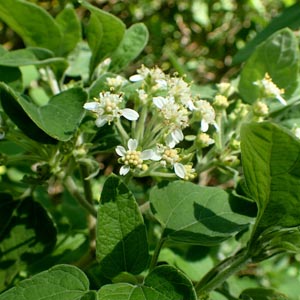Montanoa tomentosa. A review of the new scientific evidence on pharmacological properties

Accepted: April 1, 2022
All claims expressed in this article are solely those of the authors and do not necessarily represent those of their affiliated organizations, or those of the publisher, the editors and the reviewers. Any product that may be evaluated in this article or claim that may be made by its manufacturer is not guaranteed or endorsed by the publisher.
Montanoa tomentosa is a shrub, belonging to the Asteraceae family, originally from Mexico and Central America, and it is known for its medicinal properties. The origins of its use in the field of herbal medicine can be traced back to the Mexican tradition. It was used for sexual dysfunctions. The extract of leaves was used in women to induce menstruation, abortion and labor, and also to reduce postpartum bleeding. The leaves are also used for their diuretic properties and the ground roots are used in the treatment of dysentery. Over time, studies have been conducted to identify the compounds responsible for the therapeutic activity and their mechanism of action. Two studies conducted in rats demonstrated the aphrodisiac properties of Montanoa tomentosa. This activity has been attributed to the presence of components that act as oxytocic agents. Furthermore, other studies have shown that Montanoa has anxiolytic properties. The mechanism underlying this action lies in the interaction with the GABAA receptor. However, it has been shown that the anxiolytic effect is influenced by the individual endocrine status: in conditions of low hormone levels the anxiolytic effect is more pronounced; in conditions of high hormonal levels, a state like anxiety is observed. Despite the multiple properties of Montanoa, today’s research is geared towards strengthening its clinical relevance as a natural antidepressant agent.
Cervantes V, La Llave P, Lexarza JJ. Novorum vegetabilium descriptiones. 1825;2:11.
Tropical Plants Database. Ken fern. Accessed: 2020-10-11. Available from: tropical.theferns.info
Braca A, Cioffi G, Morelli I, et al. Two new sesquiterpene lactones from Montanoa tomentosa ssp. microcephala. Planta Med 2001;67:774-6. DOI: https://doi.org/10.1055/s-2001-18362
Levine SD, Adams RE, Chen R, et al. Zoapatanol and montanol, novel oxepane diterpenoids, from the Mexican plant zoapatle (Montanoa tomentosa). J Am Chem Soc 1979;101:3404-5. DOI: https://doi.org/10.1021/ja00506a057
Quijano L, Calderon J S, Gomez-Garibay F, et al. Acyclic precursors of the uterotonic oxepane diterpenoids of “zoapatle” (Montanoa tomentosa). Phytochemistry 1985;24:2741-3. DOI: https://doi.org/10.1016/S0031-9422(00)80714-1
Enriques RG, Escobar LI, Romero ML, et al. Determination of grandiflorenic acid in organic and aqueous extracts of Montanoa tomentosa (zoapatle) by reversed-phase high-performance liquid chromatography. J Chromatogr 1983;258:297-301. DOI: https://doi.org/10.1016/S0021-9673(00)96430-6
Lozoya X, Enriques RG, Bejar E, et al. The zoapatle. The effect of kauradienoic acid upon uterine contractility. Contraception 1983;27:267-79. DOI: https://doi.org/10.1016/0010-7824(83)90005-7
Quijano L, Calderon JS, Gomez F, Rios T. Zoapatanolide A and B, two new heliangolides from Montanoa tomentosa. Phytochemistry 1982;21:2041-4. DOI: https://doi.org/10.1016/0031-9422(82)83039-2
Quijano L, Gomez GF, Calderon JS, et al. Zoapatanolides C and D, two guaianolides from Montanoa tomentosa. Phytochemistry 1984;23:125-7. DOI: https://doi.org/10.1016/0031-9422(84)83090-3
Seaman FC, Malcolm AJ, Fronczek FR, et al. Montanoa terpenes. Part 4. Guaianolide-type sesquiterpene lactones of Montanoa tomentosa subsp. xanthifolia and M. tomentosa subsp. rosei and the molecular structures of two pumilin analogs. Phytochemistry 1984;23:817-22. DOI: https://doi.org/10.1016/S0031-9422(00)85034-7
Castro V, Jakupovic J. Two further 6,12-cis-germacranolides from Montanoa tomentosa subsp. xanthifolia. Phytochemistry 1985;24:2449-50. DOI: https://doi.org/10.1016/S0031-9422(00)83065-4
Topcu G, Cordell GA, Farnsworth NR, Fong HHS. Studies on zoapatle. VIII: Novel cytotoxic sesquiterpenes lactones from Montanoa tomentosa ssp. microcephala. J Pharm Sci 1988;77:553-6. DOI: https://doi.org/10.1002/jps.2600770620
Oshima Y, Gordell GA, Fong HHS. Studies on zoapatle. III. Flavonoid glycosides from Montanoa tomentosa ssp. tomentosa. J Nat Prod 1986;49:551-2. DOI: https://doi.org/10.1021/np50045a041
Carro-Juárez M, Franco MÁ, Rodríguez-Peña M de L, et al. Increase of the ejaculatory potency by the systemic administration of aqueous crude extracts of Cihuapatli (Montanoa genus) plants in spinal male rats. J Evid Based Complementary Altern Med 2014;19:43-50. DOI: https://doi.org/10.1177/2156587213510006
Carro-Juárez M, Cervantes E, Cervantes-Méndez M, Rodríguez-Manzo G. Aphrodisiac properties of Montanoa tomentosa aqueous crude extract in male rats. Pharmacol Biochem Behav 2004;78:129-34. DOI: https://doi.org/10.1016/j.pbb.2004.03.001
Sollozo-Dupont I, Estrada-Camarena E, Carro-Juarez M, Lopez-Rubalcava C. GABAA/benzodiazepine receptor complexmediates the anxiolytic-like effect of Montanoa tomentosa. J Ethnopharmacol 2015;162:278-86. DOI: https://doi.org/10.1016/j.jep.2014.12.070
Estrada-Camarena E, Sollozo-Dupont I, Islas-Preciado D, et al. Anxiolytic- and anxiogenic-like effects of Montanoa tomentosa (Asteracea): dependence on the endocrine condition. J Ethnopharmacol 2019;241:112006. DOI: https://doi.org/10.1016/j.jep.2019.112006
Lagunes-Merino O, Rodriguez-Landa JF, Caba M, et al. Acute effect of an infusion of Montanoa tomentosa on despair-like behavior activation of oxytocin hypothalamic cells in wistar rats. J Tradit Complement Med 2019;10:45-51. DOI: https://doi.org/10.1016/j.jtcme.2019.01.005
Cioffi G, Bellino A, Pizza C, et al. Triterpene Saponins from Tupidanthuscalyptratus. J Nat Prod 2001;64:750-3. DOI: https://doi.org/10.1021/np000375y
Rodríguez-Landa JF, Rodríguez-Santiago M, Rovirosa Hernández MJ, et al. Aqueous crude extract of Montanoa tomentosa exerts anxiolytic-like effects in female rats with long-term absence of ovarian hormones. J Chem Biol Phys Sci 2014;4:37-47.
PAGEPress has chosen to apply the Creative Commons Attribution NonCommercial 4.0 International License (CC BY-NC 4.0) to all manuscripts to be published.


 https://doi.org/10.4081/jbr.2022.9399
https://doi.org/10.4081/jbr.2022.9399



